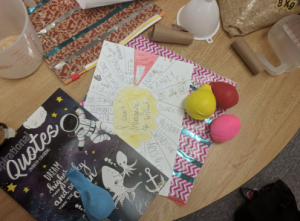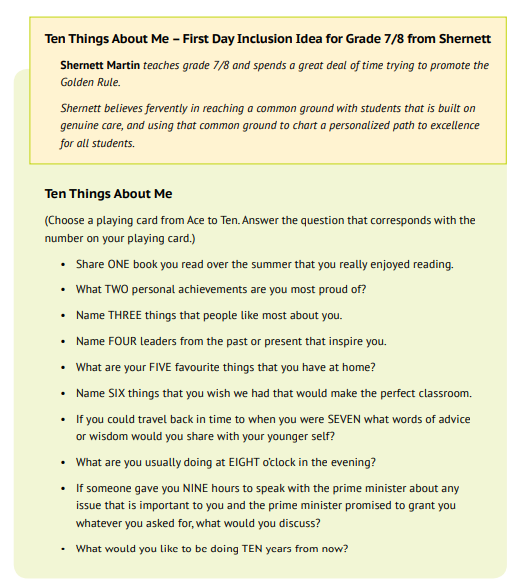For years I’ve worked with students around designing solutions for real problems in the world around us. I’ve asked students to consider the problem from a variety of perspectives and as of late, I wonder if there’s more that can be done about solving these complex problems.
In my role at Future Design School, I’ve had the privilege of facilitating workshops for students. In working with students over the past few weeks, I’m learning more and more about the importance of having the opportunity to understand the problem from the user’s perspective as well. Now I know that this seems like something that I should have known or thought of more in depth before, but it’s something that I honestly hadn’t. When students are creating, it’s important for them to understand that what they create has an impact on those for whom they are creating. In order for students to really empathize with users, they have to first be able to understand the needs of their users. They have to really take the time to stop and hear their stories through the development of open questions. How might we help students to do this?
Being Conscious of Assumptions
In the past, I’ve asked students to be thinking about a variety of users as they solved problems. As such, they worked to create general and perhaps broad-sweeping solutions but what if they were empowered to create for a specific user? With a specific user’s needs and motivations in mind, might this impact the effectiveness of their potential solutions? When we think about user-centered design, that’s what it’s really about. The user. Without taking the time to consider a potential user, I’ve asked students to make big assumptions that we never had the opportunity to test. When we make these assumptions, especially without being explicit about the fact that we are making assumptions, we hinder the ability to create the most effective solution. This makes me think about students again creating for the teacher, rather than meeting the needs of the user, which is definitely the purpose of user-centered design. So how do we go about helping students to understand the needs of their users and move past assumption making and perhaps into assumption testing? I think it’s about interviews!
Interviews
When students are able to interact with real users and ask big questions about the problem they are hoping to solve, the have a real opportunity to have an impact. That being said, there’s a fine art to the interview. When thinking about learning more from our users, it’s important to not lead them with the types of questions that we may ask. By having open questions that really get the user talking about their experiences, you’re better able to understand the problem from their perspective. Often times, through listening, you’re also able to better understand how they feel about a situation based on what they aren’t saying. A great way to get users talking about their experiences is using the TED framework for questioning: Tell me…Explain…Describe. By starting off questions in this way, we empower the user to actually talk about the problem without leading them.
Helping students to craft interview questions that are open is a great start. Once they’ve crafted the question, it’s great to have them interview potential users in teams. One person can ask the questions while someone else can write. If there is a third person in the group, they might also make notes to capture their understanding of what the user is saying. Don’t have access to potential users? Sometimes you can use videos to help.
Watching Videos
Last year, I was working with grade 5 students on solutions to natural disasters. Because it was related to a real problem that was happening in the world, students were able to read articles that contained interviews as well as watch videos to be able to better understand their users. I used this video to help students understand the problem but it wasn’t until after, that I noticed how rich it could have been in helping students understand the problem from the perspectives of different users. Perhaps curating different videos or guiding students in finding their own might be a way to help them build empathy for a specific user. Again, this might be another time to discuss assumptions that might be made as we don’t have the chance to ask clarifying questions of the users.
I’m always looking for ways in which to make student learning meaningful and relevant. I’ve also always believed that design is a great tool for doing just that. Now my focus is shifting to empowering students to build deep empathy and truly making sure that their designs are user-centered.

 When building out toolkits, students used ideas from our discussions and activities from our sessions together to help build their own physical kits. We started off with ziploc bags and students decorated them with duct tape. This really was an idea from one of the students who had used it in the past to create her own pencil cases and she thought it would be a great – and inexpensive – way to personalize our own toolkits. Once the toolkits were designed, it was time to think about the items that they wanted to include.
When building out toolkits, students used ideas from our discussions and activities from our sessions together to help build their own physical kits. We started off with ziploc bags and students decorated them with duct tape. This really was an idea from one of the students who had used it in the past to create her own pencil cases and she thought it would be a great – and inexpensive – way to personalize our own toolkits. Once the toolkits were designed, it was time to think about the items that they wanted to include.  Wellness Journal
Wellness Journal  March 22nd, 2019 was
March 22nd, 2019 was  This project reminds me of a great investigation that the students in
This project reminds me of a great investigation that the students in  Earth Hour is an international event usually held on the last Saturday of March between 8:30-9:30pm. During this hour, citizens around the world turn off their lights in support of addressing climate change. Schools typically participate on the Friday prior to the official Earth Hour by turning off all non-essential electricity for one hour during the school day. Yesterday was Earth Hour and it’s always so much fun seeing great tweets about how people are working to do their part for the environment. It’s also fantastic to see big cities all around the world, turning off the lights on prominent buildings, showing that their citizens aren’t alone in the fight but that government also has a role to play.
Earth Hour is an international event usually held on the last Saturday of March between 8:30-9:30pm. During this hour, citizens around the world turn off their lights in support of addressing climate change. Schools typically participate on the Friday prior to the official Earth Hour by turning off all non-essential electricity for one hour during the school day. Yesterday was Earth Hour and it’s always so much fun seeing great tweets about how people are working to do their part for the environment. It’s also fantastic to see big cities all around the world, turning off the lights on prominent buildings, showing that their citizens aren’t alone in the fight but that government also has a role to play. 
 Chapter 2 ends with classroom set-up. As many of you know, I was a passionate advocate of flexible seating in the classroom. Years ago, my students worked on a Math project where they re-designed our classroom while taking into consideration their learning needs. They measured the classroom and petitioned our Principal for some money for items they thought would better meet their learning needs. Some wanted standing tables while other wanted opportunities to sit on the floor. We created a learning environment that worked best for us and the autonomy and increased levels of ownership in the classroom were an indication that students felt as thought the classroom was their space. Now I know that we were lucky in that we were given some money to redesign but since leaving that school, I learned 2 important lessons: where possible, let students design the space so they feel that sense of ownership in the space and be intentional about what you chose to include in your classroom space. This picture of our space looks quite full and I would have to say that every item spoke to who we were as a group. On pages 25 to 30, I love that each of the classroom learning spaces are different and yet the amazing educators can speak to the differences that they have included in their classrooms with intentionality. I just started feeling a little nostalgic about designing learning spaces!
Chapter 2 ends with classroom set-up. As many of you know, I was a passionate advocate of flexible seating in the classroom. Years ago, my students worked on a Math project where they re-designed our classroom while taking into consideration their learning needs. They measured the classroom and petitioned our Principal for some money for items they thought would better meet their learning needs. Some wanted standing tables while other wanted opportunities to sit on the floor. We created a learning environment that worked best for us and the autonomy and increased levels of ownership in the classroom were an indication that students felt as thought the classroom was their space. Now I know that we were lucky in that we were given some money to redesign but since leaving that school, I learned 2 important lessons: where possible, let students design the space so they feel that sense of ownership in the space and be intentional about what you chose to include in your classroom space. This picture of our space looks quite full and I would have to say that every item spoke to who we were as a group. On pages 25 to 30, I love that each of the classroom learning spaces are different and yet the amazing educators can speak to the differences that they have included in their classrooms with intentionality. I just started feeling a little nostalgic about designing learning spaces! Ideas
Ideas